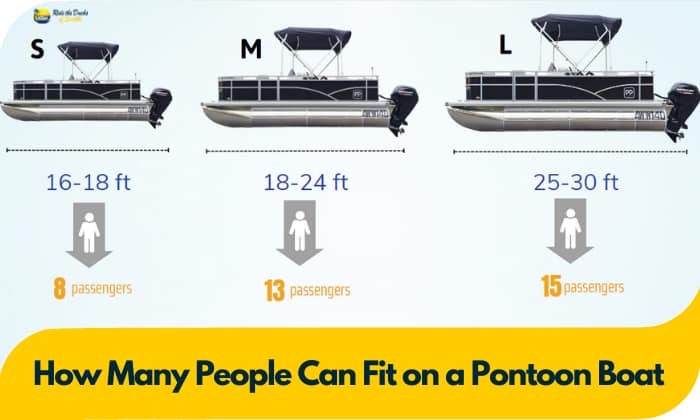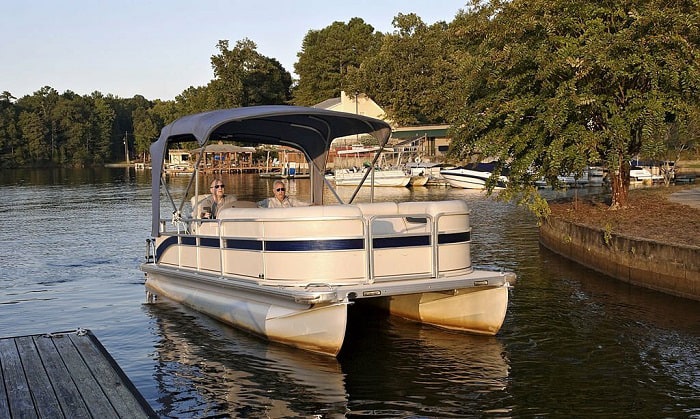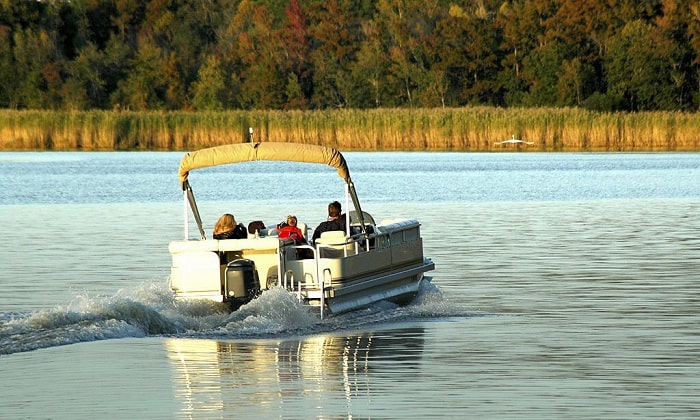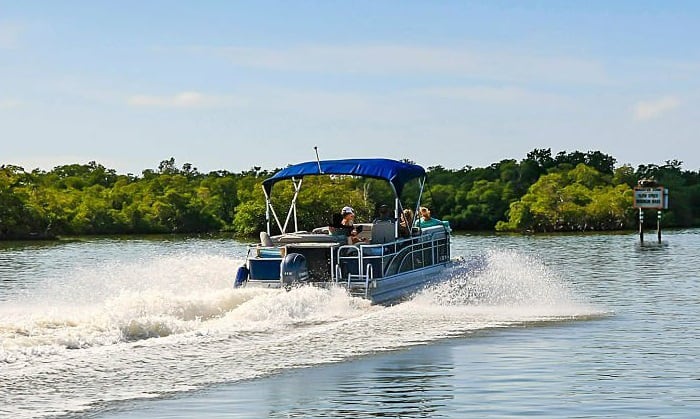If you’re a first-time boat owner or it’s your first time to rent a boat for some day cruising, you probably asked, how many people can fit on a pontoon boat?
It may seem a basic question and a matter of simple calculations. But knowing proper boat capacity can help you gauge how small or large the party you can bring.
As a general guideline, boats with lengths of 16-18 ft can carry up to 8 passengers, boats spanning 18-24 ft can carry up to 13 passengers, and finally, boats that go from 25-30 ft, can carry up to 15 passengers.
However, other factors must be considered before sending those party invites. From boat capacity to safety tips, here’s everything you need to know.
Table of Contents
Types of Pontoon Boats
These boats come in different models and sizes. You must identify which category your boat falls under to have a better idea. Here is a simple guide:
| Size | Pontoon Boat’s Dimensions (L x W) | Max. no. of passengers | Suitable for: | |
| Small | 16-18 ft | 8-8.5 ft | 8 | Fishing in calm waters |
| Mid-sized | 18-24 ft | 8.5 ft | 13 | Lakes and rivers without large or harsh waves |
| Large | 25-30 ft | 8.5-10 ft | 15 | Waterskiing and wakeboarding |
Weight of Pontoon Boats
Typically, Pontoon Boats weigh 2,200 lbs. including the motor. This gives you an idea of your boat’s weight which is around 100 lbs. per foot of the boat. Take note this is only an estimate.
Examples are:
- Avalon Eagle 16’, which weighs 1,350 lbs. dry weight
- G3 Suncatcher 22’ X22RF, which weighs 3,600 lbs. total package weight
- Lowe SS210 20′, which weighs 1,860 lbs. dry hull (including 115hp motor).
Aside from the pontoon boat sizes and weight, take note of some models as well.
For example, there are Pontoon Boats with Double-Deck features. Some people prefer this model as it provides additional room for passengers and shade on the lower deck.
Determining Pontoon Boat Capacity
Apart from the weight of the total passengers, you need to consider the weight of equipment, gear, and the boat’s motor or engine as well.
That is why, even with Pontoon Boats with a Double-Deck feature, you must check the total weight capacity of both the Upper and Lower decks.
There are three different ways to know your boat’s overall maximum weight capacity.
1. Look for the Capacity Plate
The most recommended way is to look for the ‘Capacity Plate’ or ‘Capacity Sticker’ usually located on the captain’s seat. The plate contains pertinent information like how many passengers and what is the overall weight the boat can carry.
2. Consult with the Boat Dealer or Manufacturer
If you can’t find the sticker or are only renting a boat, you can search in the boat manual or check with the boat dealer or manufacturer. The experts will provide you with the pontoon weight limit.
3. Pontoon Capacity Calculator
Another way to know is to take your boat’s dimensions (length and width) and divide it by 15 to get the maximum total number of passengers allowed.
(L x W) / 15 = Number of passengers
The formula above is applicable to standard pontoon boats. However, the weight displacement differs if you have a cylindrical shaped or metal pontoon. Below are the steps to calculating:
- Get the volume of the boat in cubic feet and find the area using r(2)
- Multiply the measurements by length, preferably in inches, to make it easier
- Divide what you got in cubic inches by 1,728. The latter is cubic inches of one foot
- Measure the water’s buoyancy and divide it by half since the boat is submerged
- Deduct the weight of the metal pontoon (make sure to include the flooring)
- Now you have the Weight Capacity
Take note both formulas are estimates. These are guidelines meant to give you rough ideas of the maximum capacity.
There are actual differences when you take into account the boat’s equipment gear, and water conditions. The latter pertains to buoyancy.
For example, a saltwater’s buoyancy in pounds differs from a freshwater’s. Your boat may float or wade through better and easier versus a particular body of water.
For easier calculations, you can try this Pontoon Water Displacement calculator.
Pontoon Boat Safety Guidelines
Before you go on a cruise, take note of the following safety practices:
1. Never overload your boat
This is the first safety rule to keep in mind. Overloading your boat leads to many negative effects–and these are the last things you want to happen:
- Capsizing – when you go over the boat’s maximum weight capacity, you risk capsizing it. This holds true, especially in a small pontoon boat. Your boat may sink or may easily tip over given the heavy weight.
- Poor Performance – going overweight can slow down your boat even when you are going at a leisurely speed. While Pontoon Boats are not necessarily meant for pulling tubes, wakeboards, etc., the engine may have a hard time working when there is too much pressure from the boat’s weight itself.
- Legal Issues – if you’re going on a cruise in more public waters, the Coast Guard may flag you if your boat carries passengers exceeding the limit. You may be fined for violating laws and government legislation.
After all, each boat’s ‘Capacity Plate’ exists as it underwent manufacturer tests and laws to ensure the safety of passengers. Some states have differing policies though so better double-check.
2. Distribute weight throughout your boat
Even if you don’t go over the maximum capacity, you must strategize where to place personal belongings and equipment. You want to avoid your boat sinking because all the weight (passengers and belongings) are all on one end.
To distribute evenly, take note of where the engine/heavy internal parts of the boat are, and avoid them when placing equipment (e.g., sound system, food storage, etc.).
3. Install or station safety equipment
While your goal is to avoid going overweight, you must account for accessories and equipment that ensure the safety of passengers. These include fire extinguishers, starboard, floatation devices (e.g., life jackets and tubes), ports, and horns.
Some of these are heavy and add to the total weight of the boat. Yet these are essential to help you in case of emergencies and as part of compliance with state laws.
Conclusion
Whether you are planning a casual hang-out or a small celebration on a cruise, you probably asked, “How many people can fit on a pontoon boat?” It all depends on what the Capacity Sticker indicates.
If the boat lacks it, you can use the formula of multiplying the length and width of the boat and dividing by 15 to get a maximum number of passengers.
Remember, this is a guideline. As always, it is best to consult a boat dealer or an expert to ensure safety.

Ten years of enjoying countless trips on boats never made me love them any less! So I am here to put all those experiences into good use for other boaters who want to have a safe and fun trip with their friends and families.




